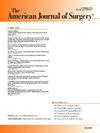癌症死亡率热点的种族/民族和社会经济差异:多州地理空间分析
IF 2.7
3区 医学
Q1 SURGERY
引用次数: 0
摘要
我们试图确定乳腺癌、结直肠癌、肺癌和前列腺癌的县级癌症死亡率热点,并评估种族/民族差异背后的结构性因素和社会脆弱性指数(SVI)的贡献。方法本生态分析包括了代表高(如马萨诸塞州)、中等(如俄亥俄州)和低(如密西西比州)GDP类别的州。癌症热点被定义为癌症死亡率高的县。结果密西西比州的癌症热点地区SVI较高(乳房:95.9对82.8),家庭收入中位数较低(34,808美元对43,766美元),主要是黑人(63.7%对35.1%)(所有p <;0.05)。俄亥俄州热点地区的食品不安全(17%对13%)、吸烟(肺部:29%对23%)和肥胖(结肠直肠:41%对38%)的比例更高(所有p <;0.05)。在密西西比州,结构性种族主义的差异更为突出,而在俄亥俄州,社会经济劣势更为突出。结论受社会脆弱性和经济差距的影响,癌症死亡热点地区不成比例地集中在低gdp国家。本文章由计算机程序翻译,如有差异,请以英文原文为准。
Racial/ethnic and socioeconomic disparities in cancer mortality hotspots: A multi-state geospatial analysis
Introduction
We sought to identify county-level cancer mortality hotspots for breast, colorectal, lung, and prostate cancers, as well as evaluate contributions of structural factors underlying racial/ethnic disparities, and social vulnerability index (SVI).
Methods
This ecological analysis included states selected to represent high (i.e., Massachusetts), medium (i.e., Ohio), and low (i.e., Mississippi) GDP categories. A cancer hotspot was defined as a county with elevated cancer mortality rates.
Results
Cancer hotspots in Mississippi consisted of higher SVI (breast: 95.9 vs. 82.8), lower median household income ($34,808 vs. $43,766), and predominantly Black populations (63.7 % vs. 35.1 %) (all p < 0.05). Ohio hotspots had higher rates of food insecurity (17 % vs. 13 %), smoking (lung: 29 vs. 23 %), and obesity (colorectal: 41 % vs. 38 %) (all p < 0.05). In Mississippi, disparities rooted in structural racism were more prominent, whereas socioeconomic disadvantage was more prominent in Ohio.
Conclusion
Cancer mortality hotspots are disproportionately concentrated in low-GDP states, driven by social vulnerability and economic disparities.
求助全文
通过发布文献求助,成功后即可免费获取论文全文。
去求助
来源期刊
CiteScore
5.00
自引率
6.70%
发文量
570
审稿时长
56 days
期刊介绍:
The American Journal of Surgery® is a peer-reviewed journal designed for the general surgeon who performs abdominal, cancer, vascular, head and neck, breast, colorectal, and other forms of surgery. AJS is the official journal of 7 major surgical societies* and publishes their official papers as well as independently submitted clinical studies, editorials, reviews, brief reports, correspondence and book reviews.

 求助内容:
求助内容: 应助结果提醒方式:
应助结果提醒方式:


